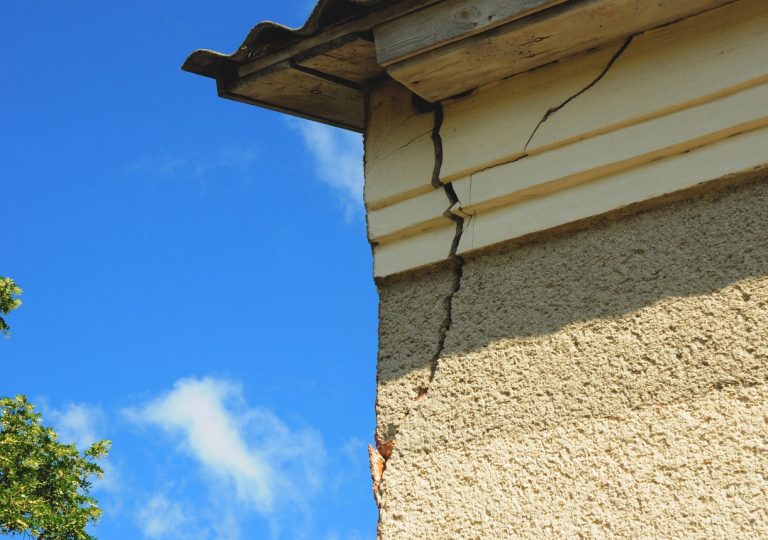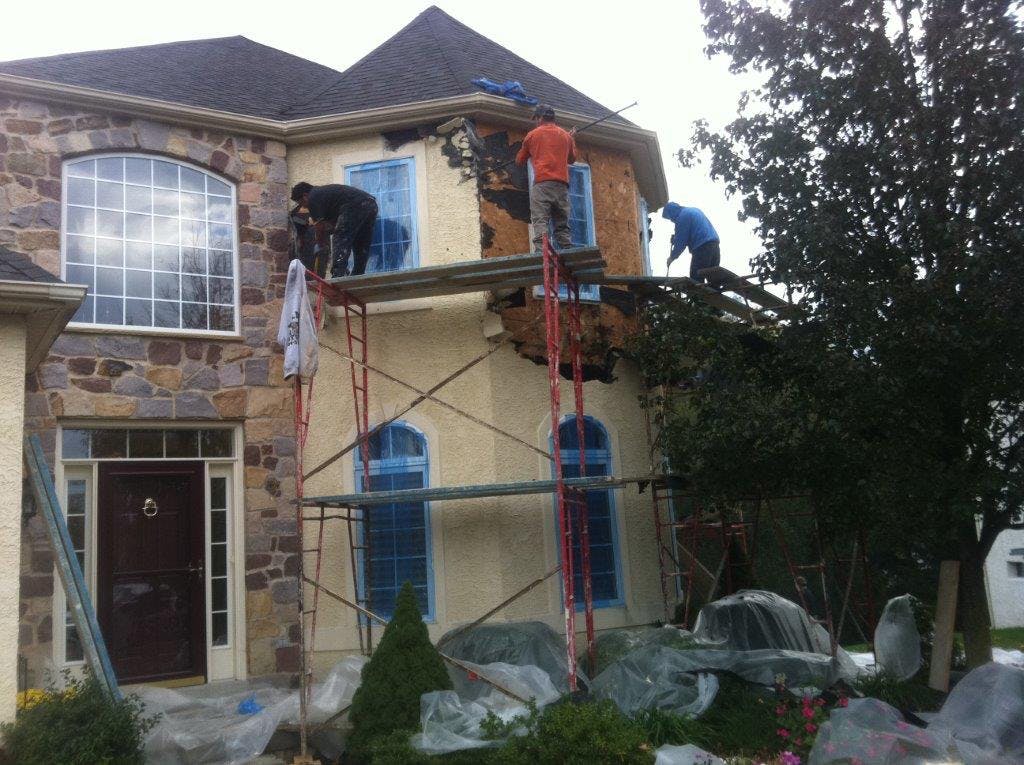When should stucco be repaired?
To repair stucco, you can use any number of commercially sold products. While some are designed to remedy larger gouges and holes, others are meant specifically to fix cracks like the one you describe. Quikrete, for example, manufactures a sanded (textured) acrylic caulk that’s both easy to use and effective.
The first step may seem counterintuitive: Using a cold chisel and hammer, widen the crack to at least a quarter inch. The edges of the crack should be chiseled perpendicular to the wall. If possible, back cut the crack so that its base is slightly wider than its top. Then clear all loose debris from the crack with a wire brush.
Now use a standard caulk gun to apply the stucco repair compound along the crack. As you go along, trowel the patch so that it matches the surrounding stucco finish. Allow the repair to cure for 24 hours, then cover it with a water-based paint, preferably the same color as the home’s exterior.
You may notice that despite having cured, the finished job feels flexible to the touch. That elasticity actually attests to the strength of the repair. Should the wall move slightly in the future, the patch will adjust rather than come undone. With the crack now properly repaired, you can rest assured that precipitation will not be able to get behind the stucco.

Types Of Stucco Cracks
There are several types of cracks that will occur in stucco walls. They come about due to different factors, and these will inform how you repair stucco cracks. Here’s what you should be looking for, to identify the types of cracks you have in your stucco.
- Hairline Cracks: These cracks are very thin, usually about 1/16 of an inch wide, or smaller. These are the most common types of cracks that you’ll see. They come about for several different reasons. They’re most common in new homes, as the plaster settles and moves during construction. Drying timber, shifting foundations, and construction work will all sometimes lead to hairline cracks.
- Foam Trim Cracks: The foam trim used on stucco will sometimes form cracks too. If you see cracking here, it’s a sign that fiberglass mesh tape wasn’t used in installing the foam trim. Expansion and shrinkage will then lead to cracking over time.
- Spider Cracking: These cracks in your stucco look like spider webs, hence the name. If you’re seeing this in your stucco, it’s a sign that the base coat wasn’t allowed to cure properly. This could be because there was too much water in the mix, it dried too quickly, or the temperature wasn’t right the day it was applied.
- Pattern Cracking: You may see cracking that follows a pattern on your walls. Most commonly, it shows up like a grid of horizontal and vertical lines on your stucco. This cracking happens because there are problems with the way the lath was installed. It’s probably not nailed on properly, which will lead to more cracks over time.
- Diagonal Cracking: These cracks, as the name implies, are diagonal in nature, and often are seen around doors and windows. These happen due to seismic changes in the foundation, leading to them shifting. If these cracks are wider than other cracks on your stucco, you’ll want to attend to these first.

What is Stucco Repair?
Stucco repair refers to the fixing of damage at the surface level. Most often, repair is used for damage resulting from an outside force such as something striking and breaking the material. Cracks may also develop in certain areas over time that can be quickly repaired.
Benefits of Repair
The two main benefits of repair over remediation are that it’s both quicker and cheaper. Since repairs are generally surface-level fixes, they don’t require the extensive work that remediation does. Additionally, because repairs can be performed by less-skilled workers, the cost is cheaper than remediation would be.
When Should You Repair?
Repair should generally only be done if the damage to your stucco is surface level. If there are small cracks, no mold or moisture present, and the stucco is relatively new, repair might be all you require. However, in some cases, it will take a thorough check by an experienced stucco repair person to determine whether the damage is surface level or the result of larger, underlying issues.
Why it goes wrong
From the smallest of cracks to blistering walls– not addressing your stucco’s damage quickly and properly could lead to big problems and even bigger repair costs. Here are some of the most common causes of stucco damage, and how you can identify them.
Water Damage
Water damage is the most common and most expensive form of stucco damage. It can occur for several different reasons:
- Weather: Things like rainstorms, earthquakes, hailstorms or strong winds can easily damage your stucco.
- Improper Composition: When stucco – a mixture of Portland cement, sand and water – isn’t balanced and mixed properly it can result in water damage.
- Improper Installation: Even properly balanced and mixed stucco can’t avoid water damage if it was installed improperly. This can occur if a flashing – an attached piece of metal used to prevent water from passing through – is installed incorrectly, or if your stucco was installed with gaps or holes.
- Interior Issues: Though environmental causes are most common when it comes to stucco water damage, your problem could be coming from indoors. Water damage can be caused by a burst pipe, a leaky air conditioner or even a misplaced sprinkler that has water landing on your walls, not your flower beds.
What you should know about repairing stucco
If you already have plaster or stucco on the exterior walls of your home, you should know that it can be significantly more expensive to remove it entirely and start from scratch than to work with a professional stucco contractor to repair and refinish it. Plus, you can avoid making a big mess of your house by getting a professional involved right from the get-go.
The pros will come out to your property and perform a close inspection of the stucco. The first thing they’ll want to find out is how well the stucco on your walls is still attached to its lath (the wooden slats that keep it attached to the wall’s framework). This will help them determine if repair is truly an option or if the stucco needs to be entirely replaced. They’ll also want to get a sense of the surface quality of the stucco to determine the extent and type of repairs they’ll need to make.
Based on this inspection, the pros will be able to determine the best techniques to use to reattach the stucco layer to the lath, then repair the surface damage and repaint it to make sure the stucco looks like it’s brand new.
A big factor to look at is the size and shape of the cracks, as this will indicate the type of problem you’re facing. Minor stress cracks occasionally happen because of the natural expanding and contracting that happens through the seasons. These types of cracks can easily be filled with a strong mesh fabric that expands and contracts along with the wall. Larger cracks often run diagonally, and can indicate a surface pulling away from the lath. This can be fixed by installing a “plaster button,” a sort of washer that runs through the plaster to affix it to the lath.
The only situation in which stucco pros will really wash their hands of the job and suggest replacement is if there is significant crumbling of the surface.